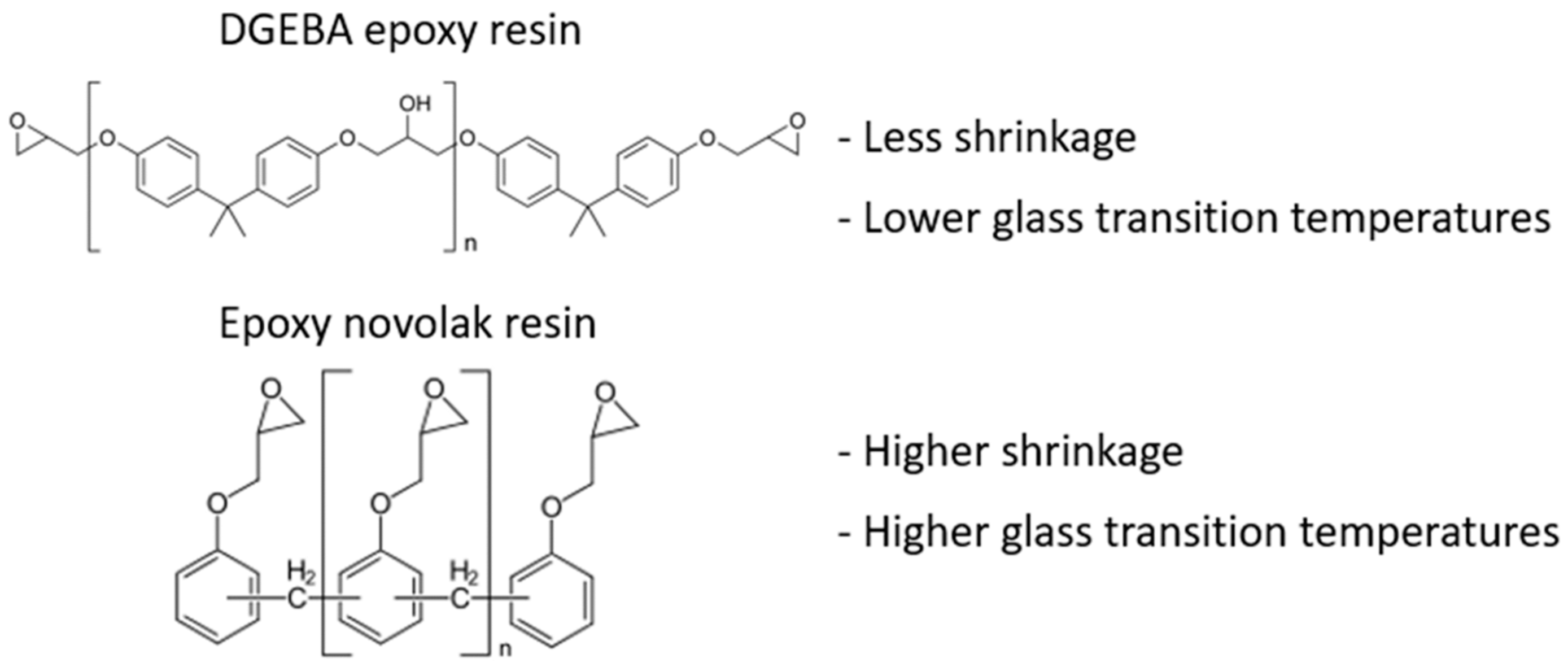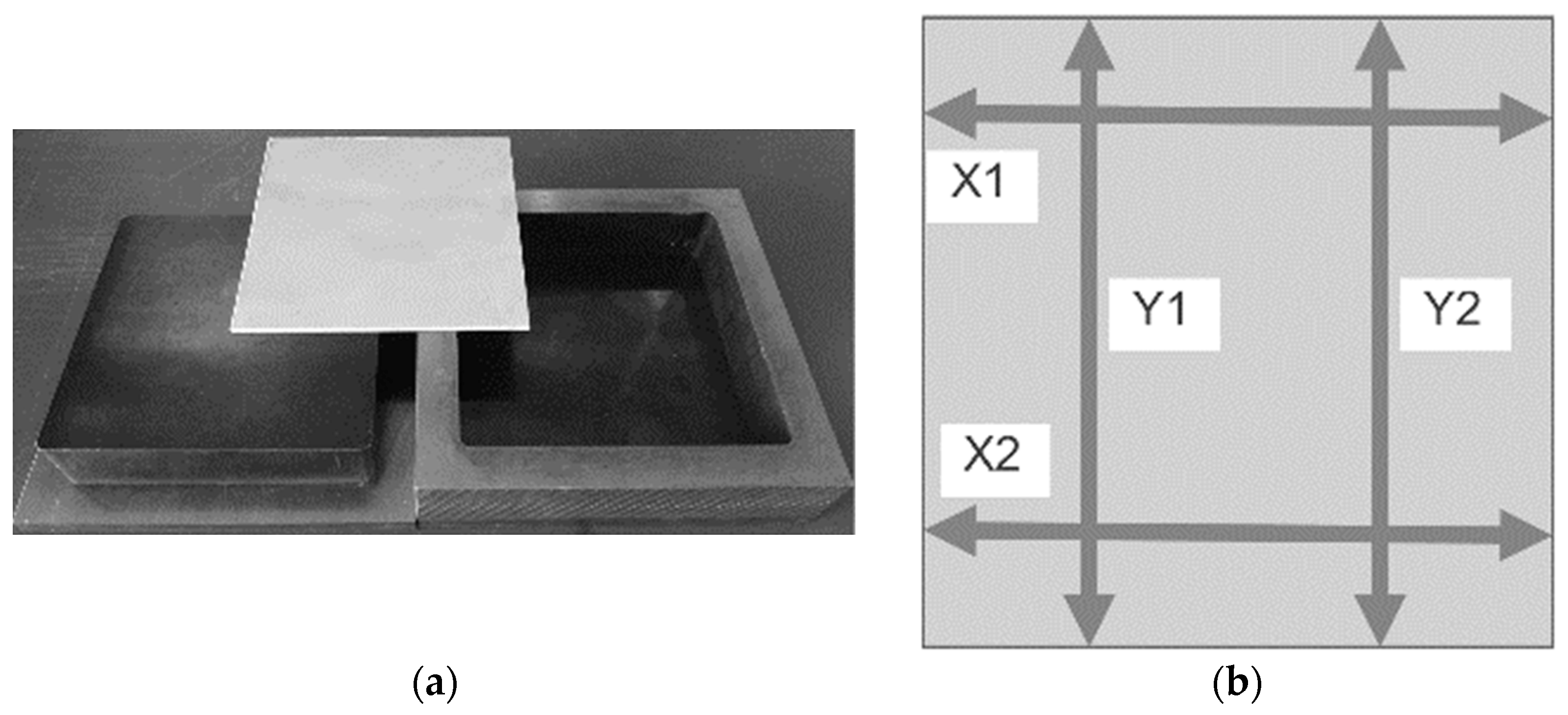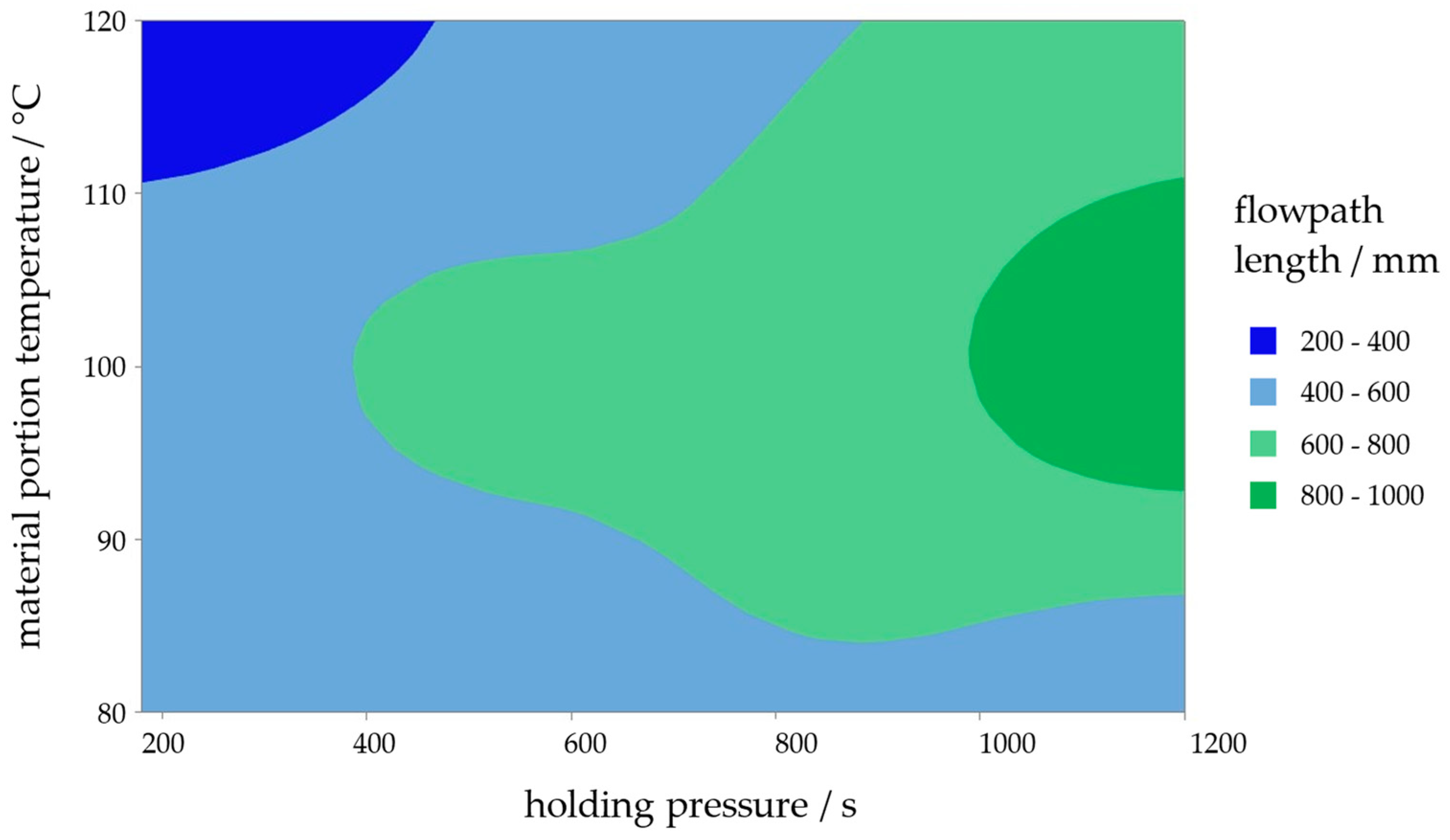Development of a Low-Expansion and Low-Shrinkage Thermoset Injection Moulding Compound Tailored to Laminated Electrical Sheets
Abstract
1. Introduction
- Buckling of the liner due to fluid pressure;
- Detachment of the liner from the stator;
- Cracking in the liner.
2. Material Development
2.1. Material Requirements
2.2. Material Tailoring Strategy
- Low CTE;
- Low shrinkage.
3. Experimental Screening
3.1. Materials and Methods
3.1.1. Differential Scanning Calorimetry (DSC)
3.1.2. Thermomechanical Analysis (TMA)
3.1.3. Thermogravimetric Analysis (TGA)
3.1.4. Shrinkage
3.1.5. Tensile Testing
3.2. Results and Discussion
4. Validation
4.1. Mechanical Behaviour
4.2. Flow Path Length
5. Conclusions
6. Patents
Author Contributions
Funding
Data Availability Statement
Conflicts of Interest
References
- Liu, M.; Li, Y.; Ding, H.; Sarlioglu, B. Thermal management and cooling of windings in electrical machines for electric vehicle and traction application. In Proceedings of the 2017 IEEE Transportation Electrification Conference and Expo (ITEC), Chicago, IL, USA, 22–24 June 2017; IEEE: Piscataway, NJ, USA, 2017; pp. 668–673, ISBN 978-1-5090-3953-1. [Google Scholar]
- Schiefer, M.; Doppelbauer, M. Indirect slot cooling for high-power-density machines with concentrated winding. In Proceedings of the 2015 IEEE International Electric Machines & Drives Conference (IEMDC), Coeur d’Alene, ID, USA, 10–13 May 2015; IEEE: Piscataway, NJ, USA, 2015; pp. 1820–1825, ISBN 978-1-4799-7941-7. [Google Scholar]
- Doppelbauer, M. Grundlagen der Elektromobilität: Technik, Praxis, Energie und Umwelt; Springer Vieweg: Wiesbaden/Heidelberg, Germany, 2020; ISBN 978-3-658-29729-9. [Google Scholar]
- Doppelbauer, M. Introduction to Electromobility: Technology, Best Practice, Energy and Environment, 2024 ed.; Springer Fachmedien Wiesbaden GmbH; Springer Vieweg: Wiesbaden, Germany, 2024; ISBN 9783658454814. [Google Scholar]
- Lange, J.; Wachter, S.; Engelhardt, T.; Oechslen, S.u.; Heitmann, A. (Eds.) Highly Integrated Electric Axle, S. 13–30. In In Proceedings of the E-Motive 11th International Conference: Expert Forum on Electric Vehicle Drives and e-Mobility, Schweinfurt, Germany, 4–5 September 2019. [Google Scholar]
- Tschöke, H.; Gutzmer, P.; Pfund, T. Elektrifizierung des Antriebsstrangs: Grundlagen—Vom Mikro-Hybrid zum vollelektrischen Antrieb; Springer Vieweg: Berlin/Heidelberg, Germany, 2019; ISBN 978-3-662-60355-0. [Google Scholar]
- Nonneman, J.; T’Jollyn, I.; Vanhee, S.; de Paepe, M. Thermal Modelling and Validation of a Direct Rotor Cooled Permanent Magnet Electric Machine. In Proceedings of the 2023 IEEE International Electric Machines & Drives Conference (IEMDC), San Francisco, CA, USA, 15–18 May 2023; IEEE: Piscataway, NJ, USA, 2023; pp. 1–5, ISBN 979-8-3503-9899-1. [Google Scholar]
- Petrov, I.; Lindh, P.; Niemela, M.; Scherman, E.; Wallmark, O.; Pyrhonen, J. Investigation of a Direct Liquid Cooling System in a Permanent Magnet Synchronous Machine. IEEE Trans. Energy Convers. 2020, 35, 808–817. [Google Scholar] [CrossRef]
- Langheck, A.; Reuter, S.; Saburow, O.; Maertens, R.; Wittemann, F.; Berg, L.F.; Doppelbauer, M. Evaluation of an integral injection molded housing for high power density synchronous machines with concentrated single-tooth winding. In Proceedings of the 2018 8th International Electric Drives Production Conference (EDPC), Schweinfurt, Germany, 4–5 December 2018; IEEE: Piscataway, NJ, USA, 2018. ISBN 9781728101484. [Google Scholar]
- Jaguemont, J.; van Mierlo, J. A comprehensive review of future thermal management systems for battery-electrified vehicles. J. Energy Storage 2020, 31, 101551. [Google Scholar] [CrossRef]
- Fraunhofer-Institut für Chemische Technologie ICT. PerKuel—Fraunhofer ICT. Available online: https://www.ict.fraunhofer.de/de/projekte/PerKuel.html (accessed on 9 January 2024).
- Oechslen, S.; Heitmann, A.; Engelhardt, T.; Reuss, H.-C. Thermal simulation of an electric motor in continuous and circuit operation. In Proceedings of the 16th Internationales Stuttgarter Symposium Automobil- und Motorentechnik, Stuttgart, Germany, 15–16 March 2016; Bargende, M., Reuss, H.-C., Wiedemann, J., Eds.; Springer Vieweg: Wiesbaden, Germany, 2016; pp. 1041–1054, ISBN 978-3-658-13254-5. [Google Scholar]
- Oechslen, S. Thermische Modellierung Elektrischer Hochleistungsantriebe. Ph.D. Thesis, University of Stuttgart, Stuttgart, Germany, 2018. [Google Scholar]
- Thumm, P.; Oechslen, S.; Berendes, P. Direct Cooling of Electric Machines for Vehicles under Long-term Testing in Climatic Limit Operation on a Test Bench. MTZ Worldw. 2024, 85, 48–51. [Google Scholar] [CrossRef]
- Lieuchy, S. VYNCOLIT X7530. Available online: https://www.sbhpp.com/products-applications/catalog/item/vyncolit-x7530/?category=vyncolit (accessed on 11 April 2024).
- Huntsman Corporation. Huntsman Product Portfolio. Available online: https://www.huntsman.com/products/detail/371/aratherm (accessed on 11 April 2024).
- Duresco. DATENBLÄTTER—Duresco. Available online: https://www.duresco.ch/produkte/datenblaetter/ (accessed on 11 April 2024).
- Hübsch, J.D.; Rosendahl, P.L.; Mittelstedt, C. An analytical failure model for pressurized blister tests of thermally loaded composite laminates. Compos. Part B Eng. 2021, 214, 108588. [Google Scholar] [CrossRef]
- Hübsch, J.D. Eine Auslegungsmethode für direkt einlaminierte Dichthülsen in elektrischen Antriebsmaschinen. Shaker Verlag: Herzogenrath, Germany, 2021. [Google Scholar]
- Amkreutz, M.; Kolbe, J.; Nagel, C. Simulation des Härtungsschrumpfes von Klebstoffen zur Berücksichtigunge bei der Bauteilauslegung. Available online: https://www.ifam.fraunhofer.de/content/dam/ifam/de/documents/Klebtechnik_Oberflaechen/Adhaesions_und_Grenzflaechenforschung/simulation_h%C3%A4rtungsschrumpf_%20jb_2009_fraunhofer_ifam.pdf (accessed on 15 February 2024).
- Li, C.; Potter, K.; Wisnom, M.R.; Stringer, G. In-situ measurement of chemical shrinkage of MY750 epoxy resin by a novel gravimetric method. In Composites Science and Technology; Elsevier: Amsterdam, The Netherlands, 2004; pp. 55–64. [Google Scholar]
- Sun, Q.; Feng, Y.; Guo, J.; Wang, C. High performance epoxy resin with ultralow coefficient of thermal expansion cured by conformation-switchable multi-functional agent. Chem. Eng. J. 2022, 450, 138295. [Google Scholar] [CrossRef]
- Resources—ED2 CORPORATION (2024). Online verfügbar unter. Available online: https://ed2corp.com/wp-content/uploads/2023/07/THERMALS-AND-GLASS-ED2-FUSED-SILICA.pdf (accessed on 16 July 2023).
- Demleitner, M.; Schönl, F.; Angermann, J.; Fässler, P.; Lamparth, I.; Rist, K.; Schnur, T.; Catel, Y.; Rosenfeldt, S.; Retsch, M.; et al. Influence of Block Copolymer Concentration and Resin Crosslink Density on the Properties of UV-Curable Methacrylate Resin Systems. Macro Mater. Eng. 2022, 307, 2200320. [Google Scholar] [CrossRef]
- Hübner, F.; Brückner, A.; Dickhut, T.; Altstädt, V.; Rios de Anda, A.; Ruckdäschel, H. Low temperature fatigue crack propagation in toughened epoxy resins aimed for filament winding of type V composite pressure vessels. Polym. Test. 2021, 102, 107323. [Google Scholar] [CrossRef]
- ISO 11357-1:2023; Plastics—Differential scanning calorimetry (DSC). ISO: Geneva, Switzerland, 2023.






| Type | Unit/Symbol | Duresco NU 6110 | Huntsman Aratherm® CW 2731 | Sbhpp Vyncolit® X7530 |
|---|---|---|---|---|
| Glass transition temperature | TG/°C | 160 | 165 | 224 |
| Thermal expansion | α/10−6/K | 18 | 24 | 10‖/41┴ |
| Shrinkage | ΔV/% | 0.2–0.7 | - | 0.15 |
| Tensile strength | σ/MPa | 80 | 80 | 123 |
| Elongation at break | ε/% | 1.2 | 0.4 | 0.95 |
| Tensile modulus | E/MPa | 18,000 | 23,000 | 17,000 |
| Type | Unit/Symbol | Target Value |
|---|---|---|
| Glass transition temperature/TG | TG/°C | ≈150 |
| Thermal expansion (CTE) | α/10−6/K | <16 |
| Shrinkage | ΔV/% | <0.25 |
| Tensile strength @ 23 °C | σ/MPa | >80 |
| Elongation at break @ 23 °C | ε/% | >0.75 |
| Tensile modulus @ 23 °C | E/MPa | >7000 |
| Tensile modulus @ 135 °C | E/MPa | >4000 |
| TG/°C | |
|---|---|
| Benchmark | 179 |
| Formulation 1 | 134 |
| Formulation 2 | 130 |
| Formulation 3 | 125 |
| Formulation 4 | 148 |
| Formulation | CTE 10−6/K | Processing Method |
|---|---|---|
| Reference | 22.5 | - |
| Formulation 4_neat | 78 | Dissolver |
| Formulation 4_50 wt.-% | 42.5 | Dissolver |
| Formulation 4_60 wt.-% * | 40 | Dissolver |
| Formulation 4_70 wt.-% | 22 | Three-roll mill |
| Formulation 4_75 wt.-% | 12.5 | Three-roll mill |
| Formulation | Theoretical Additive Content/wt.-% | Measured Additive Content/wt.-% |
|---|---|---|
| Formulation 4_50 wt.-% | 50 | 49.8 |
| Formulation 4_60 wt.-% | 60 | 59.1 |
| Formulation 4_70 wt.-% | 70 | 69.8 |
| Formulation 4_75 wt.-% | 75 | 76.0 |
| Formulation 4_75 wt.-% | Dimension of Tool/mm | Dimension of Sample/mm | Shrinkage /% |
|---|---|---|---|
| /% | |||
| X1 | 150.49 | 150.35 | 0.09 |
| X2 | 150.45 | 150.30 | 0.10 |
| Y1 | 149.94 | 149.76 | 0.12 |
| Y2 | 149.95 | 149.74 | 0.14 |
| Combined shrinkage | 0.11 ± 0.02 |
| Temperature /°C | Tensile Strength /MPa | Tensile Modulus /MPa | Elongation @ Break/% |
|---|---|---|---|
| −40 | 134 ± 9 | 16,980 ± 1127 | 1.0 ± 0.1 |
| 23 | 114 ± 8 | 15,980 ± 1603 | 1.0 ± 0.2 |
| 135 | 85.8 ± 13 | 7254 ± 1850 | 3.4 ± 0.2 |
| 150 | 46.3 ± 3 | 4042 ± 439.4 | 3.2 ± 0.3 |
| Type | Unit | Target Value | Reference | Novel Formulation |
|---|---|---|---|---|
| Glass transition temperature | TG/°C | 150 | 175 | 148 |
| Thermal expansion | α/10−6 K−1 | <16 | 22.5 | 12.5 |
| Shrinkage | ΔV/% | <0.25 | 0.25 | 0.11 |
| Tensile strength @ 23 °C | σ/MPa | >50 | 80 | 114 ± 8. |
| Elongation at break @ 23 °C | ε/% | >0.75 | 0.5 | 1.0 ± 0.2 |
| Tensile modulus @ 23 °C | E/MPa | >7000 | 18,000 | 15,980 ± 1603 |
| Tensile modulus @ 135 °C | E/MPa | >4000 | - | 7254 ± 1850 |
Disclaimer/Publisher’s Note: The statements, opinions and data contained in all publications are solely those of the individual author(s) and contributor(s) and not of MDPI and/or the editor(s). MDPI and/or the editor(s) disclaim responsibility for any injury to people or property resulting from any ideas, methods, instructions or products referred to in the content. |
© 2024 by the authors. Licensee MDPI, Basel, Switzerland. This article is an open access article distributed under the terms and conditions of the Creative Commons Attribution (CC BY) license (https://creativecommons.org/licenses/by/4.0/).
Share and Cite
Braunbeck, F.; Schönl, F.; Preußler, T.; Reuss, H.-C.; Demleitner, M.; Ruckdäschel, H.; Berendes, P. Development of a Low-Expansion and Low-Shrinkage Thermoset Injection Moulding Compound Tailored to Laminated Electrical Sheets. World Electr. Veh. J. 2024, 15, 319. https://doi.org/10.3390/wevj15070319
Braunbeck F, Schönl F, Preußler T, Reuss H-C, Demleitner M, Ruckdäschel H, Berendes P. Development of a Low-Expansion and Low-Shrinkage Thermoset Injection Moulding Compound Tailored to Laminated Electrical Sheets. World Electric Vehicle Journal. 2024; 15(7):319. https://doi.org/10.3390/wevj15070319
Chicago/Turabian StyleBraunbeck, Florian, Florian Schönl, Timo Preußler, Hans-Christian Reuss, Martin Demleitner, Holger Ruckdäschel, and Philipp Berendes. 2024. "Development of a Low-Expansion and Low-Shrinkage Thermoset Injection Moulding Compound Tailored to Laminated Electrical Sheets" World Electric Vehicle Journal 15, no. 7: 319. https://doi.org/10.3390/wevj15070319
APA StyleBraunbeck, F., Schönl, F., Preußler, T., Reuss, H.-C., Demleitner, M., Ruckdäschel, H., & Berendes, P. (2024). Development of a Low-Expansion and Low-Shrinkage Thermoset Injection Moulding Compound Tailored to Laminated Electrical Sheets. World Electric Vehicle Journal, 15(7), 319. https://doi.org/10.3390/wevj15070319






